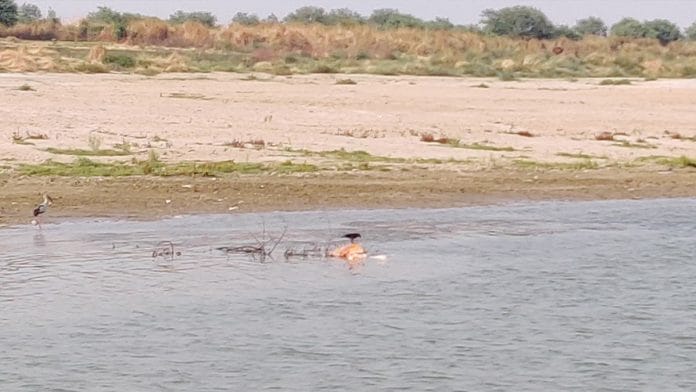For residents living close to Ganga and Yamuna, witnessing dead bodies is a routine affair. But nothing could have prepared the residents of Hamirpur in Uttar Pradesh and Buxar in Bihar, or anyone receiving the latest viral videos, for what is now going to be forever etched in their memory — floating dead bodies, unattended for several days, as the second wave of the Covid-19 pandemic engulfs India.
The country was stunned. Even though there is a provision in Hinduism of immersing the dead, the sheer numbers in the past two weeks suggest something is amiss. There was no dignity in death.
The visuals have left an indelible mark in the minds and hearts of everyone who watched the viral clips, but especially those who witnessed it first hand. And so, the image of corpses floating in Ganga and Yamuna is ThePrint’s Newsmaker of the Week.
Also read: ‘1, 2, 3, 4, 5…’ — UP fishermen count floating dead as poverty, rituals drive up river burials
Psychological impact, health hazard
In Bihar’s Buxar district, as many as 71 corpses washed up at the Mahadev Ghat of the Ganga river. Local residents described the sight like “hell breaking loose.” In Hamirpur district in Uttar Pradesh, the sight of dozens of corpses floating in the river has had a similar psychological impact on the residents. But many are now also worried about the potentially massive health hazard this brings.
For fishermen, the stench of the corpses that has enveloped the river has made their lives difficult. Some say that dogs have begun mauling and dragging the dead bodies, leaving pieces of flesh floating in the river. They are worried that if these bodies continue floating, and no action is taken, then their livelihood will be at risk. “Of course it feels very disgusting to be in the river when there are so many bodies there. The stench is really horrible and the flesh pieces make it worse. But as fishermen, we have no other option,” Ratan Kumar, a fisherman living on the banks of Yamuna said.
Also read: When ‘hell’ came floating on Ganga — Bihar village in shock after 71 bodies wash ashore
Shifting blame
After reports of the visuals in Ganga and Yamuna emerged, Uttar Pradesh Chief Minister Adityanath said that “the last rites should be done according to the deceased’s religious beliefs”. The CM has now ordered patrolling by the police and the State Disaster Response Force to stop disposing of bodies in the rivers.
But Bihar and UP governments have shifted blame to each other. Buxar District Magistrate Aman Samir has denied that the corpses were from his jurisdiction, claiming they floated downstream from UP’s Ghazipur. However, Samir’s counterpart in the UP district has rejected the claim.
In UP’s Hamirpur, the police claimed that the bodies had come from Kanpur Dehat district, and not been dumped by local residents. But while bodies in Buxar were later buried, in Hamirpur, local residents allege there has not been any effort from the administration to remove the bodies.
In fact, Hamirpur’s Additional Superintendent of Police told ThePrint that removing the bodies from the river now would be “violative of the rituals.”
Also read: ‘Dead body could infect us, wood is expensive’ — tragic stories of Covid victims in Ganga
Repeat of India 1918
Many have expressed shock that this is happening in India of 2021. “We have seen bodies every year. Some float, and a fraction get washed ashore, but this time, it looked like all hell had broken loose,” Sitaram Chaudhry, a fisherman from Bihar said. The horrific second wave of Covid-19, which most experts agree the central and state governments mishandled, has led to cremation and burial grounds running out of space.
This isn’t the first time this is happening. India has had to see these visuals a century ago too.
In his book The Age of Pandemics, author Chinmay Tumbe wrote how during the 1918 influenza pandemic, similar visuals were seen in various parts of India. “Down in the plains, numberless bodies were thrown in the river…since there was insufficient firewood for the cremation of Hindus.”
https://twitter.com/ChinmayTumbe/status/1391731413985099778/photo/1
But what happened in 1918 shouldn’t be happening in 2021.
And the reasons, even today, remain more or less the same. Procuring wood is a tough ask in these times — when the commodity has become expensive and several places are reporting shortages due to excessive deaths in the past few weeks.
Even after the Bhopal gas tragedy in 1984, bodies were dumped into the Narmada because of the sheer overwhelming numbers. In fact, there was so much confusion about corpses that Muslims ended up cremating, Hindus ended up burying.
After talking to people around the ghats, it’s clear the visuals of floating bodies have shaken villagers to the core. They questioned how the government allowed the situation to deteriorate so much. “Helplessness” has set in among the bereaved families who couldn’t even cremate their loved ones. Ordinary citizens are having to take on the task of helping the less-privileged in these times. “Who will take responsibility for this? There are bodies floating all over… What happens to Namami Gange project?” asked Amit, a resident of Gahmar in Uttar Pradesh who, along with his friends, has been helping the poor with food and other needs.
Views are personal.
(Edited by Prashant Dixit)






